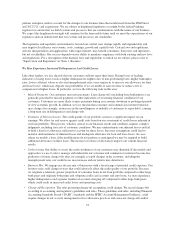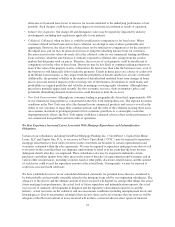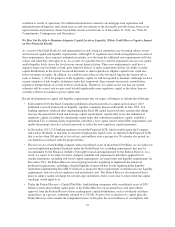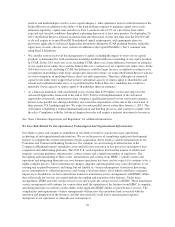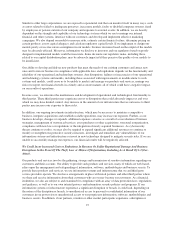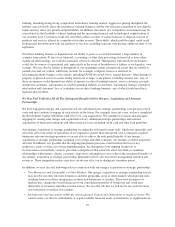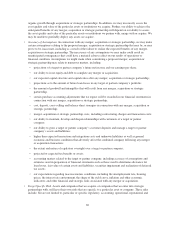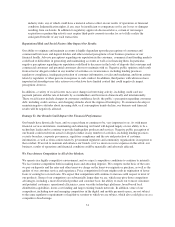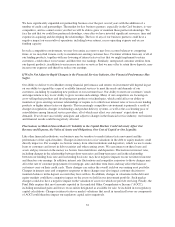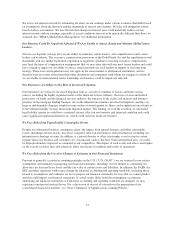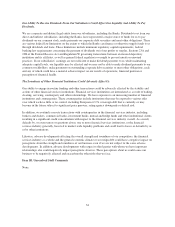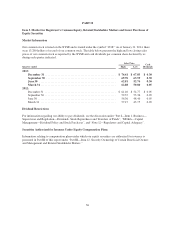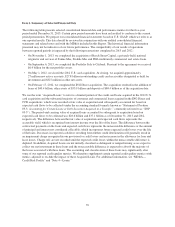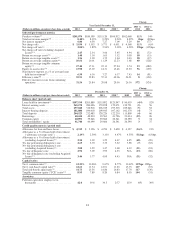Capital One 2013 Annual Report Download - page 51
Download and view the complete annual report
Please find page 51 of the 2013 Capital One annual report below. You can navigate through the pages in the report by either clicking on the pages listed below, or by using the keyword search tool below to find specific information within the annual report.industry risks, any of which could have a material adverse effect on our results of operations or financial
condition. Indemnification rights, if any, may be insufficient to compensate us for any losses or damages
resulting from such risks. In addition to regulatory approvals discussed above, certain of our merger,
acquisition or partnership activity may require third-party consents in order for us to fully realize the
anticipated benefits of any such transaction.
Reputational Risk and Social Factors May Impact Our Results.
Our ability to originate and maintain accounts is highly dependent upon the perceptions of consumer and
commercial borrowers and deposit holders and other external perceptions of our business practices or our
financial health. Adverse perceptions regarding our reputation in the consumer, commercial and funding markets
could lead to difficulties in generating and maintaining accounts as well as in financing them. In particular,
negative perceptions regarding our reputation could lead to decreases in the levels of deposits that consumer and
commercial customers and potential customers choose to maintain with us. Negative public opinion could result
from actual or alleged conduct in any number of activities or circumstances, including lending practices,
regulatory compliance, inadequate protection of customer information, or sales and marketing, and from actions
taken by regulators or other persons in response to such conduct. In addition, third parties with whom we have
important relationships may take actions over which we have limited control that could negatively impact
perceptions about us.
In addition, a variety of social factors may cause changes in borrowing activity, including credit card use,
payment patterns and the rate of defaults by accountholders and borrowers domestically and internationally.
These social factors include changes in consumer confidence levels, the public’s perception regarding consumer
debt, including credit card use, and changing attitudes about the stigma of bankruptcy. If consumers develop or
maintain negative attitudes about incurring debt, or if consumption trends decline, our business and financial
results will be negatively affected.
Damage To Our Brands Could Impact Our Financial Performance.
Our brands have historically been, and we expect them to continue to be, very important to us. As with many
financial services institutions, maintaining and enhancing our brand will depend largely on our ability to be a
technology leader and to continue to provide high-quality products and services. Negative public perception of
our brands could result from actual or alleged conduct in any number of activities, including lending practices,
security breaches, corporate governance, regulatory compliance and the use and protection of customer
information, as well as from actions taken by government regulators and community organizations in response to
that conduct. If we fail to maintain and enhance our brands, or if we incur excessive expenses in this effort, our
business, results of operations and financial condition could be materially and adversely affected.
We Face Intense Competition in All of Our Markets.
We operate in a highly competitive environment, and we expect competitive conditions to continue to intensify.
We face intense competition both in making loans and attracting deposits. We compete on the basis of the rates
we pay on deposits and the rates and other terms we charge on the loans we originate or purchase, as well as the
quality of our customer service and experience. Price competition for loans might result in origination of fewer
loans or earning less on our loans. We expect that competition will continue to increase with respect to most of
our products. Some of our competitors are substantially larger than we are, which may give those competitors
advantages, including a more diversified product and customer base, the ability to reach out to more customers
and potential customers, operational efficiencies, more versatile technology platforms, broad-based local
distribution capabilities, lower-cost funding and larger existing branch networks. In addition, some of our
competitors, including new and emerging competitors in the digital and mobile payments space, are not subject
to the same regulatory requirements or legislative scrutiny to which we are subject, which also could place us at a
competitive disadvantage.
31




